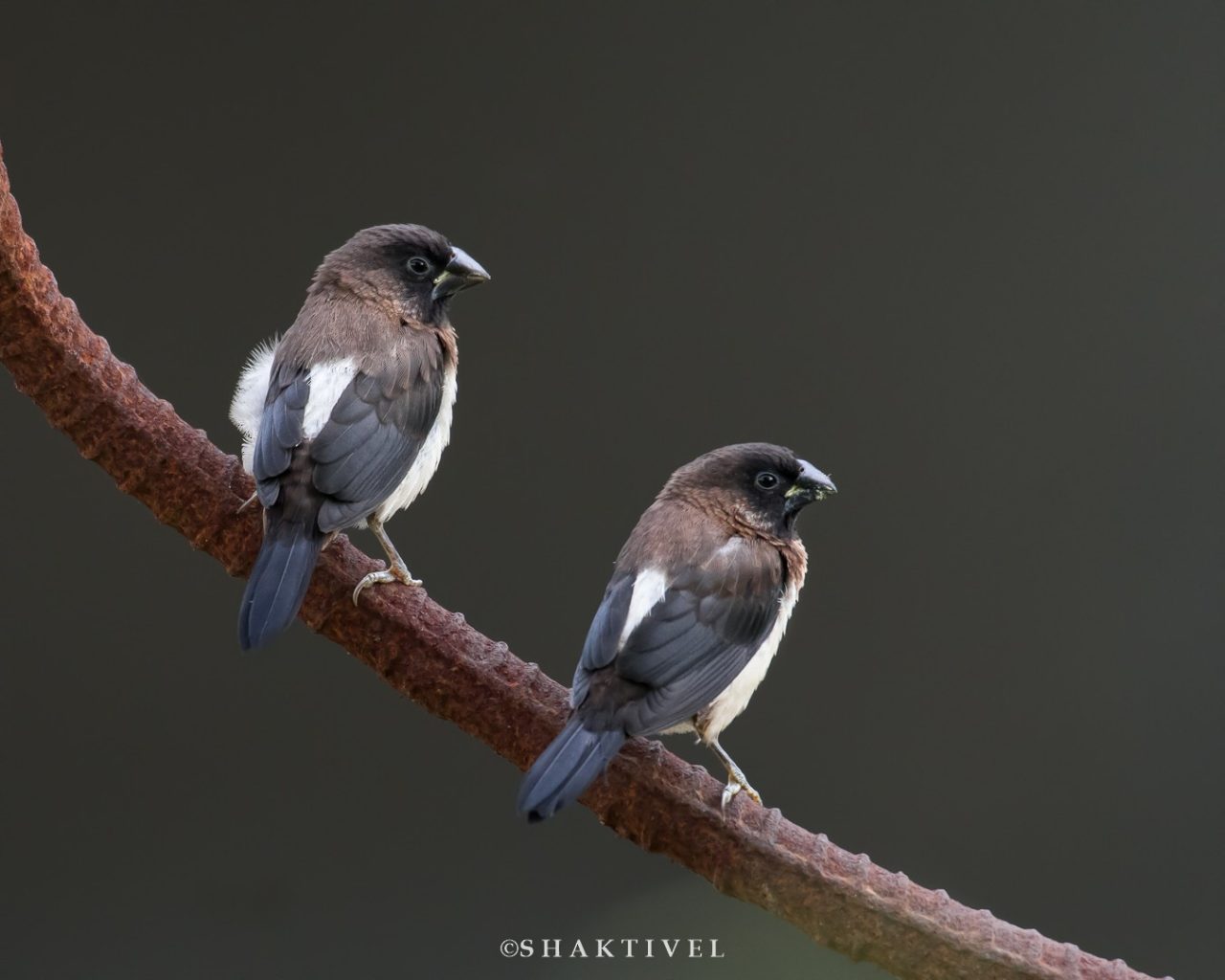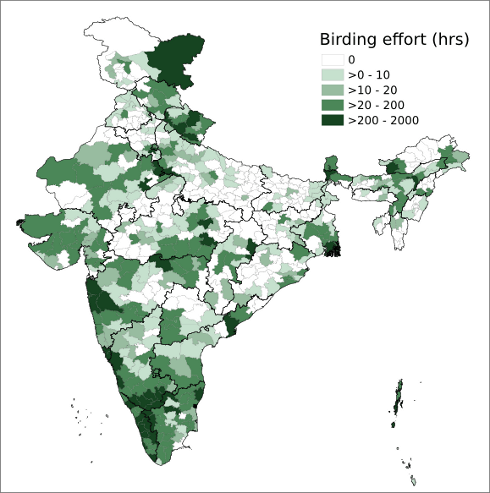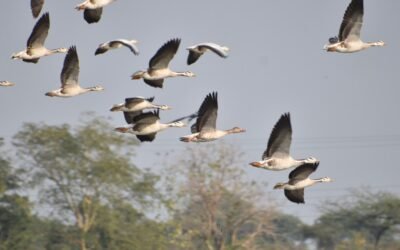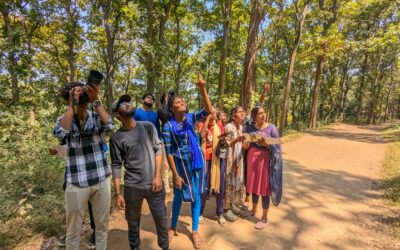By Kulbhushansingh Suryawanshi
Birders like me use eBird to maintain our sightings in a single place, to keep track of what we have seen where, and to prepare for our next birding outing by looking at the bar charts and range maps to look up what we can expect to see.
The larger purpose of eBird, of course, is to document the distribution and abundance of birds, and to investigate how this changes over the seasons and over the years. Doing so requires a large amount of information from all parts of the country. It relies on individual birders and birding groups going out birding frequently and uploading their bird lists. On the surface, we seem to be doing well in India. After all, over half a million bird records from India are now available on eBird, and the numbers are growing rapidly. Overall, 35,522 hours of birding effort in India are documented on eBird as of 9 September 2014.
These numbers sound impressive, but do they mean that we now have a good idea of distribution and abundance of Indian birds? Unfortunately, not, because all this birding effort is not spread uniformly across the country – some areas have relatively large amounts of information, and others virtually none.
About 40% of all districts in India do not have even a single effort-based list on eBird! (Effort-based lists are those that report duration and distance covered.) About 61% of districts have less than 10 hours of birding and about 87% of districts have less than 100 hours of birding reported on eBird. About 31% (10,962 hrs) of the total birding effort comes from just 10 districts in all of India! This means that the eBird database contains a woefully incomplete picture of the birds of the vast majority of districts.
To provide a quick look at how birding effort on eBird is distributed across the country, we have calculated, for each district, the total number of hours of birding represented on eBird (as of 9 Sept 2014), and have colour-coded this on the map below.
A quick glance at this map shows large gaps in information. UP and Bihar comprise a major gap which continues through Jharkhand, Orissa, Telangana and parts of Maharashtra. Parts of Madhya Pradesh, Haryana, Punjab and Kashmir are just as empty. North-east India may be highly biodiverse, but except for a few sanctuaries most of the other districts do not have any information in eBird. Even states such as Gujarat and Rajasthan, with a fair number of resident and visiting birders, have districts with no effort-based lists: twelve in Rajasthan and five in Gujarat.
Before eBird data can be used at the scale of the country, these gaps have to be filled as best as possible — which is where all of us birders come in! If you know a birder in these districts please introduce eBird to them. They will be the pioneers for their districts in contributing bird information to the largest online database of Indian bird records!
If you are yourself travelling to some of these places for work or holiday, please don’t forget to upload your bird lists from the front yard of your hotel or from a dhaba stop. If you can visit a local park or a sanctuary that would be even better!
Attached is an excel file listing the birding effort represented in eBird for all districts of the country. Take a look and identify the gaps that you can fill. If you are planning a Big Bird Day event or a Bird Race, see if it is possible to organize it in one of these unrepresented districts. Birding in less-documented areas can be fun because you don’t know what surprises may be in store!
Another way to help fill these gaps is to dig through your birding notebooks to see if you have old bird lists from these areas. If you do, it would be great to upload them and help fill in the blanks!
Appendix: Top 10 districts in terms of birding hours represented on eBird
Congratulations to the top 10 districts! If you are a birder from here, don’t slow down. Do keep birding where you are, but also consider making a trip to a neighbouring district to help fill in the gaps.
| State | District | Effort (hours) |
| Goa | North Goa | 1842.7 |
| Kerala | Idukki | 1491.1 |
| Karnataka | Mysore | 1336.2 |
| Karnataka | Bangalore | 1295.7 |
| Kerala | Thrissur | 1026.6 |
| Rajasthan | Bharatpur | 1007 |
| Kerala | Alappuzha | 763.3 |
| Goa | South Goa | 758.2 |
| Uttarakhand | Nainital | 734.8 |
| Maharashtra | Pune | 706.8 |
And here is a complete list for all districts of the country.
Header Image: White-rumped Munia Lonchura striata by Shakti Vel/ Macaulay Library






Dear Kulbhushan,
Wonderful analysis !
Just a few aspects, I would like to highlight…
1. Even in some of these districts with high number of birding hours reported, most have come from premier birding destinations visited heavily by non-resident birders. There are other parts of the same district which is least known. E.g. Idukki district has both Munnar & Periyar inside it – and would have contributed heavily to birding hours, while a large swathe of Cardomom Hill Reserve shall have zero lists as there are no resident birders in that district.
2. It might make sense to divide the # hours by size of the district. Now it look like Ladakh is well represented in terms of eBird, but considering the size of the district – its hugely under represented.
3. It would also make sense to see if the lists uploaded are *diverse* in terms of birders – are a few birders contributing to more hours or is the effort uniformly distributed among several birders. This will tell us the sustainability of monitoring in each district.
There is a category of birders who switch on their birding hats when they visit sanctuaries. To me birdwatching is a way of life. Keep your eyes open and watch birds. The idea of going to sanctuaries to watch birds should be changed. People should be incentivised to bird in greenfield areas. The Birder of the month contest should give some weightage to people who go off the beaten track such as finding new locations or do birding in remote and under represented areas. And what about a Birder of the year for consistent year round birding efforts.
“birdwatching is a way of life”
@Able Lawrence — that’s exactly what we’d like to encourage. “Always birding” is the motto! About the eBirding Challenges, they are still relatively new, and we want them to be as inclusive as possible. Perhaps next year we’ll start to focus on exploring new locations or birding in under-represented areas. Perhaps we’ll have separate efforts to encourage this. As for birder of the year, yes we will recognize birders for a variety of reasons; and will also start a more formal all-year challenge for 2015. Thanks!
Dear Praveen,
I agree with all the three points.
The objective of the current analysis was to get a quick idea of birding distribution at the scale of the entire country. The fact that districts such as Bharatput, Idukki and North Goa have amongst the highest effort is suggestive that the bulk of the reporting on eBird from India is from visiting birders and not resident birders.
The third point is very interesting, but it will require a different kind of analysis. Its a question that is often asked about any citizen science effort and there is a lot of research about it. We will need to see how eBird in India is doing with regards to it.
Thanks
“the bulk of the reporting on eBird from India is from visiting birders and not resident birders”
This may have been true in the past, but is certainly not the case now. It’s very hard to do any strict calculation, but up until Dec 2013, perhaps 80% of records in eBird may have come from visiting birders (from overseas). Since then, that proportion is probably more like 5-10% at most. (These are guesstimates, not actual calculations!)
Dear Kullu,
For point 3 – with my limited experience in such things, I can suggest to run Shannon Diversity over the lists & eBirders for each district. Perhaps, there are much better ways to do it.
Biodiversity data base is very incomplete in India. This is in spite of large number of Botany and Zoology departments in all most all science colleges and Universities where a large number of professionally trained manpower is available. But there is no unified attempt or centralized leadership by an organization or an institution to get a large number of people to collect the data region wise. Data on Birds and Mammals are more or less complete because large number of naturalists are involved in collecting the data. When it comes to plants and invertebrates there are no concerted efforts by any naturalists or societies/ clubs. A National Biodiversity Data Base is a must for initiating conservation and protection. Zoological Survey and Botanical survey group should have done this long back.
The least that can be done is get all the teachers and post graduate students of all Botany and Zoology departments all over India is made to involve in a massive survey in their respective areas. Start with birds first.
Dear Sir, that would be a very interesting and productive activity. How do you suggest one can go about this? How might it be possible to network among colleges and universities across the country? Would you be able to take a lead in this? Thank you for the suggestion!
Looks like not many birders from Andhra Pradesh (erstwhile) are loading their data here as birding effort is very low. The Bird Watchers Society of AP itself does a lot of birding and have many years of data. There must be some way to promote more uploads from Telagana and Andhra Prades
@Farida Tampal — that would be wonderful!